Comprehensive Analysis of Contract Law: Elements, Terms, and Types
VerifiedAdded on 2020/01/28
|14
|4467
|81
Report
AI Summary
This report provides a comprehensive overview of contract law, examining the essential elements required for a valid contract, including offer, acceptance, intention to create legal relations, and consideration. It analyzes the impact of different contract types, such as written, verbal, and distance selling contracts, and delves into the nuances of contractual terms, differentiating between implied, expressed terms, and exclusion clauses. The report further explores the consequences of classifying terms, distinguishing between conditions, warranties, and innominate terms, using case scenarios to illustrate practical applications. Additionally, it contrasts liability in tort with contractual liability, explaining negligence and vicarious liability within a business context. The report concludes with case studies to demonstrate the application of contract law principles.

Aspects of contract
1
1
Paraphrase This Document
Need a fresh take? Get an instant paraphrase of this document with our AI Paraphraser
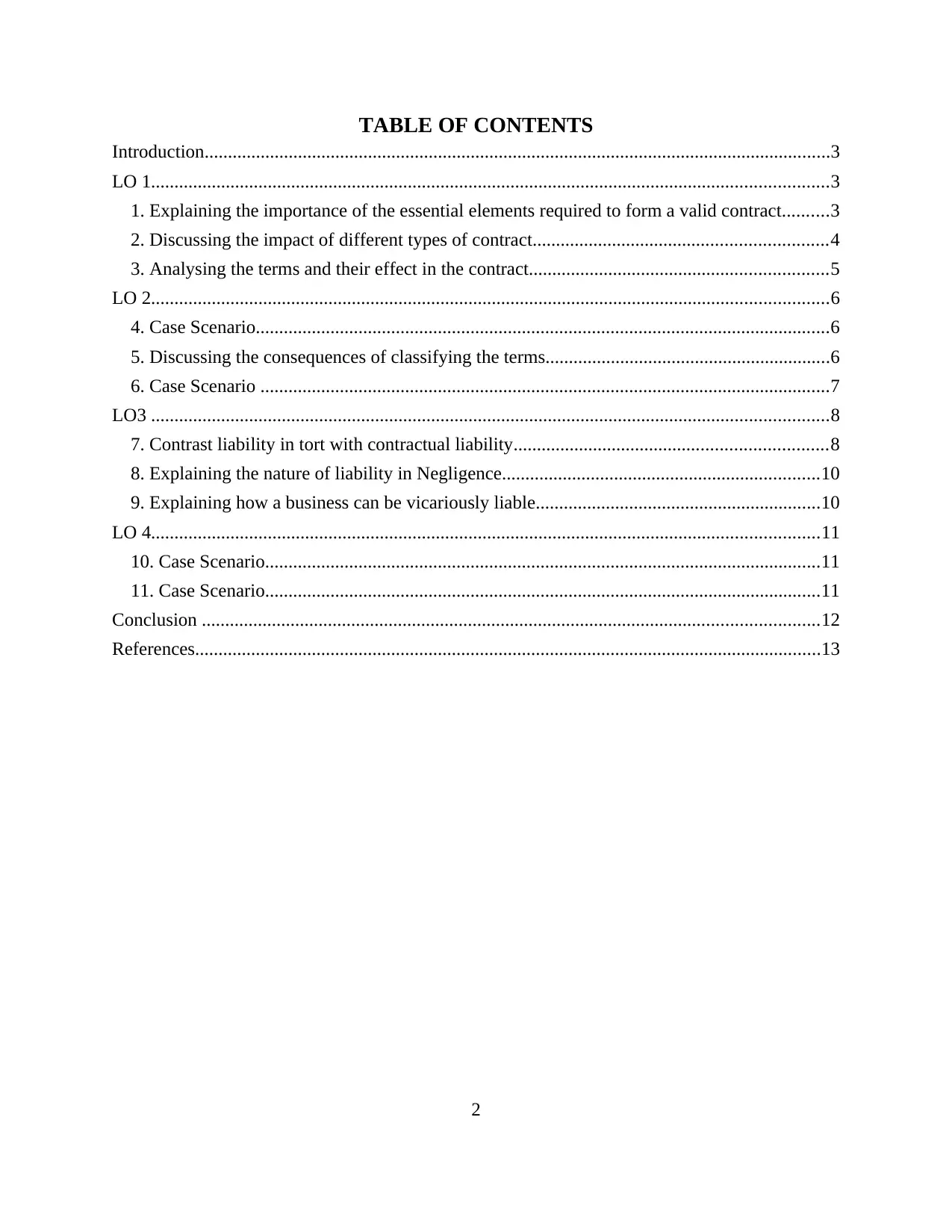
TABLE OF CONTENTS
Introduction......................................................................................................................................3
LO 1.................................................................................................................................................3
1. Explaining the importance of the essential elements required to form a valid contract..........3
2. Discussing the impact of different types of contract...............................................................4
3. Analysing the terms and their effect in the contract................................................................5
LO 2.................................................................................................................................................6
4. Case Scenario...........................................................................................................................6
5. Discussing the consequences of classifying the terms.............................................................6
6. Case Scenario ..........................................................................................................................7
LO3 .................................................................................................................................................8
7. Contrast liability in tort with contractual liability...................................................................8
8. Explaining the nature of liability in Negligence....................................................................10
9. Explaining how a business can be vicariously liable.............................................................10
LO 4...............................................................................................................................................11
10. Case Scenario.......................................................................................................................11
11. Case Scenario.......................................................................................................................11
Conclusion ....................................................................................................................................12
References......................................................................................................................................13
2
Introduction......................................................................................................................................3
LO 1.................................................................................................................................................3
1. Explaining the importance of the essential elements required to form a valid contract..........3
2. Discussing the impact of different types of contract...............................................................4
3. Analysing the terms and their effect in the contract................................................................5
LO 2.................................................................................................................................................6
4. Case Scenario...........................................................................................................................6
5. Discussing the consequences of classifying the terms.............................................................6
6. Case Scenario ..........................................................................................................................7
LO3 .................................................................................................................................................8
7. Contrast liability in tort with contractual liability...................................................................8
8. Explaining the nature of liability in Negligence....................................................................10
9. Explaining how a business can be vicariously liable.............................................................10
LO 4...............................................................................................................................................11
10. Case Scenario.......................................................................................................................11
11. Case Scenario.......................................................................................................................11
Conclusion ....................................................................................................................................12
References......................................................................................................................................13
2
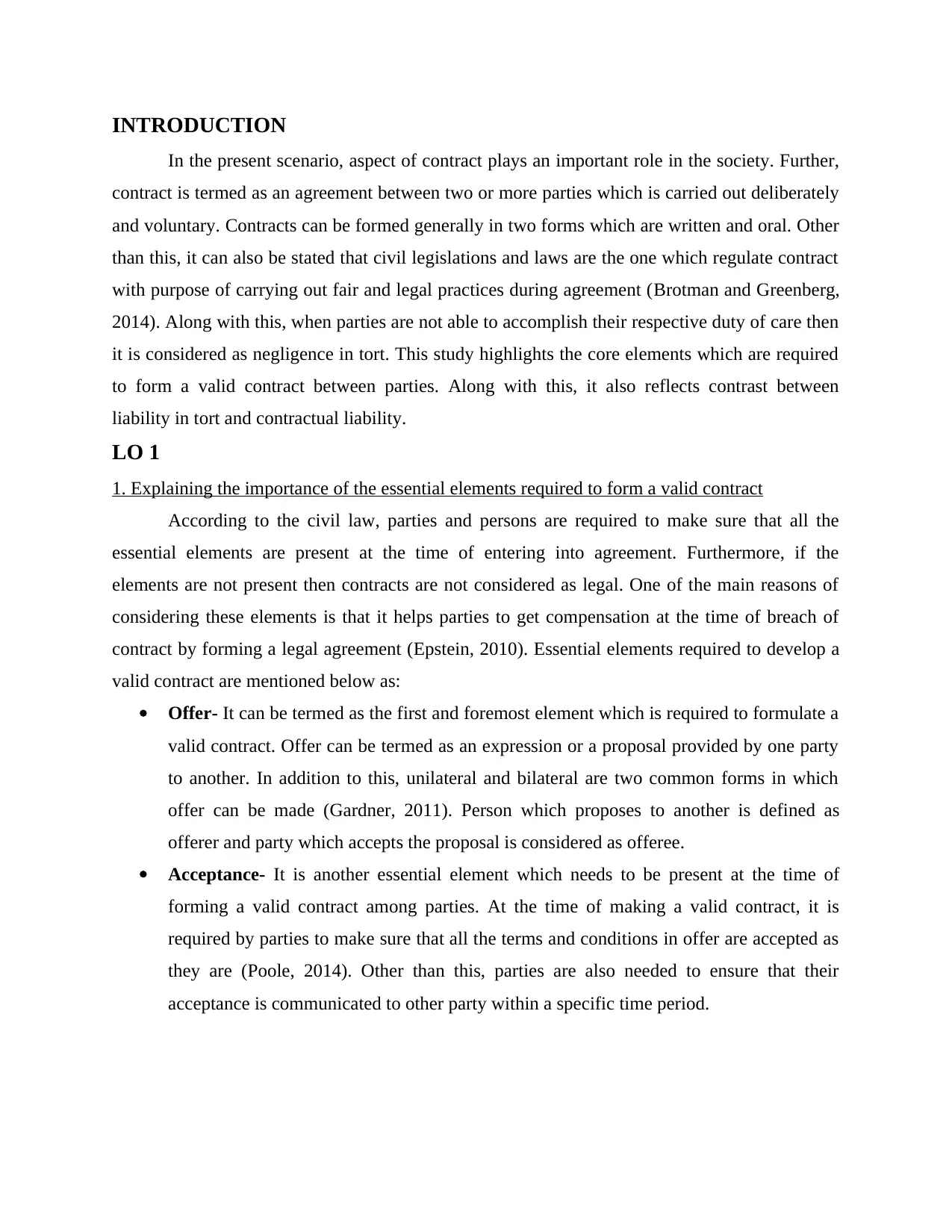
INTRODUCTION
In the present scenario, aspect of contract plays an important role in the society. Further,
contract is termed as an agreement between two or more parties which is carried out deliberately
and voluntary. Contracts can be formed generally in two forms which are written and oral. Other
than this, it can also be stated that civil legislations and laws are the one which regulate contract
with purpose of carrying out fair and legal practices during agreement (Brotman and Greenberg,
2014). Along with this, when parties are not able to accomplish their respective duty of care then
it is considered as negligence in tort. This study highlights the core elements which are required
to form a valid contract between parties. Along with this, it also reflects contrast between
liability in tort and contractual liability.
LO 1
1. Explaining the importance of the essential elements required to form a valid contract
According to the civil law, parties and persons are required to make sure that all the
essential elements are present at the time of entering into agreement. Furthermore, if the
elements are not present then contracts are not considered as legal. One of the main reasons of
considering these elements is that it helps parties to get compensation at the time of breach of
contract by forming a legal agreement (Epstein, 2010). Essential elements required to develop a
valid contract are mentioned below as:
Offer- It can be termed as the first and foremost element which is required to formulate a
valid contract. Offer can be termed as an expression or a proposal provided by one party
to another. In addition to this, unilateral and bilateral are two common forms in which
offer can be made (Gardner, 2011). Person which proposes to another is defined as
offerer and party which accepts the proposal is considered as offeree.
Acceptance- It is another essential element which needs to be present at the time of
forming a valid contract among parties. At the time of making a valid contract, it is
required by parties to make sure that all the terms and conditions in offer are accepted as
they are (Poole, 2014). Other than this, parties are also needed to ensure that their
acceptance is communicated to other party within a specific time period.
In the present scenario, aspect of contract plays an important role in the society. Further,
contract is termed as an agreement between two or more parties which is carried out deliberately
and voluntary. Contracts can be formed generally in two forms which are written and oral. Other
than this, it can also be stated that civil legislations and laws are the one which regulate contract
with purpose of carrying out fair and legal practices during agreement (Brotman and Greenberg,
2014). Along with this, when parties are not able to accomplish their respective duty of care then
it is considered as negligence in tort. This study highlights the core elements which are required
to form a valid contract between parties. Along with this, it also reflects contrast between
liability in tort and contractual liability.
LO 1
1. Explaining the importance of the essential elements required to form a valid contract
According to the civil law, parties and persons are required to make sure that all the
essential elements are present at the time of entering into agreement. Furthermore, if the
elements are not present then contracts are not considered as legal. One of the main reasons of
considering these elements is that it helps parties to get compensation at the time of breach of
contract by forming a legal agreement (Epstein, 2010). Essential elements required to develop a
valid contract are mentioned below as:
Offer- It can be termed as the first and foremost element which is required to formulate a
valid contract. Offer can be termed as an expression or a proposal provided by one party
to another. In addition to this, unilateral and bilateral are two common forms in which
offer can be made (Gardner, 2011). Person which proposes to another is defined as
offerer and party which accepts the proposal is considered as offeree.
Acceptance- It is another essential element which needs to be present at the time of
forming a valid contract among parties. At the time of making a valid contract, it is
required by parties to make sure that all the terms and conditions in offer are accepted as
they are (Poole, 2014). Other than this, parties are also needed to ensure that their
acceptance is communicated to other party within a specific time period.
⊘ This is a preview!⊘
Do you want full access?
Subscribe today to unlock all pages.

Trusted by 1+ million students worldwide

Intention to develop a legal relationship- In order to formulate a valid contract, parties
or persons must have intention to create legal relationship with each other. The rationale
behind this is that contracts such as domestic and social do not need the action of court
and thus, legal intention between parties becomes must.
Consideration- In simpler terms, consideration can be defined as something which is
provided in return from one party to another. It can also be expressed that without
consideration, legal and valid contract cannot be created (Heale and et.al., 2010). In
contract, one party agrees to carry out a particular task or promise and thus, other party
should receive something against the performance made.
2. Discussing the impact of different types of contract
In the present scenario, there are several types of contract which can be formed between
parties according to their need and demand. Furthermore, parties entering into contract are
directly or indirectly affected by the form of contract in which they have entered (Lawson,
2011). Discussion on the impact of different contract types is elaborated below as:
Written contract- It can be termed as a type of contract which is formulated by writing all
the terms and conditions associated with the agreement. Written contracts are also
considered as one of the most common types of contracts as they provide clear evidence
of all the conditions and terms on which parties have agreed (Ramanathan, 2014). It can
also be stated that such type of contracts are considered as valid only in situation when
parties have signed the agreement between them. Written contract also supports parties to
get compensation during the time of breach of contract.
Verbal contract- This contract can be termed as a type of agreement which is formed
between parties orally. One party provides offer and other accepts the same orally. This
means that there is not written agreement carried out by parties which are entering into
the contract (Scott, 2007). One of the major drawbacks of verbal contract is that it
becomes almost impossible for parties to provide the proof of contract.
Distance selling contracts- These are the contracts which are formed without the physical
presence of parties. The best example to understand such type of contract is online selling
in which one party provides offer to individuals via online. One of the major
disadvantages of formulating such type of contract is that due to distance between
4
or persons must have intention to create legal relationship with each other. The rationale
behind this is that contracts such as domestic and social do not need the action of court
and thus, legal intention between parties becomes must.
Consideration- In simpler terms, consideration can be defined as something which is
provided in return from one party to another. It can also be expressed that without
consideration, legal and valid contract cannot be created (Heale and et.al., 2010). In
contract, one party agrees to carry out a particular task or promise and thus, other party
should receive something against the performance made.
2. Discussing the impact of different types of contract
In the present scenario, there are several types of contract which can be formed between
parties according to their need and demand. Furthermore, parties entering into contract are
directly or indirectly affected by the form of contract in which they have entered (Lawson,
2011). Discussion on the impact of different contract types is elaborated below as:
Written contract- It can be termed as a type of contract which is formulated by writing all
the terms and conditions associated with the agreement. Written contracts are also
considered as one of the most common types of contracts as they provide clear evidence
of all the conditions and terms on which parties have agreed (Ramanathan, 2014). It can
also be stated that such type of contracts are considered as valid only in situation when
parties have signed the agreement between them. Written contract also supports parties to
get compensation during the time of breach of contract.
Verbal contract- This contract can be termed as a type of agreement which is formed
between parties orally. One party provides offer and other accepts the same orally. This
means that there is not written agreement carried out by parties which are entering into
the contract (Scott, 2007). One of the major drawbacks of verbal contract is that it
becomes almost impossible for parties to provide the proof of contract.
Distance selling contracts- These are the contracts which are formed without the physical
presence of parties. The best example to understand such type of contract is online selling
in which one party provides offer to individuals via online. One of the major
disadvantages of formulating such type of contract is that due to distance between
4
Paraphrase This Document
Need a fresh take? Get an instant paraphrase of this document with our AI Paraphraser
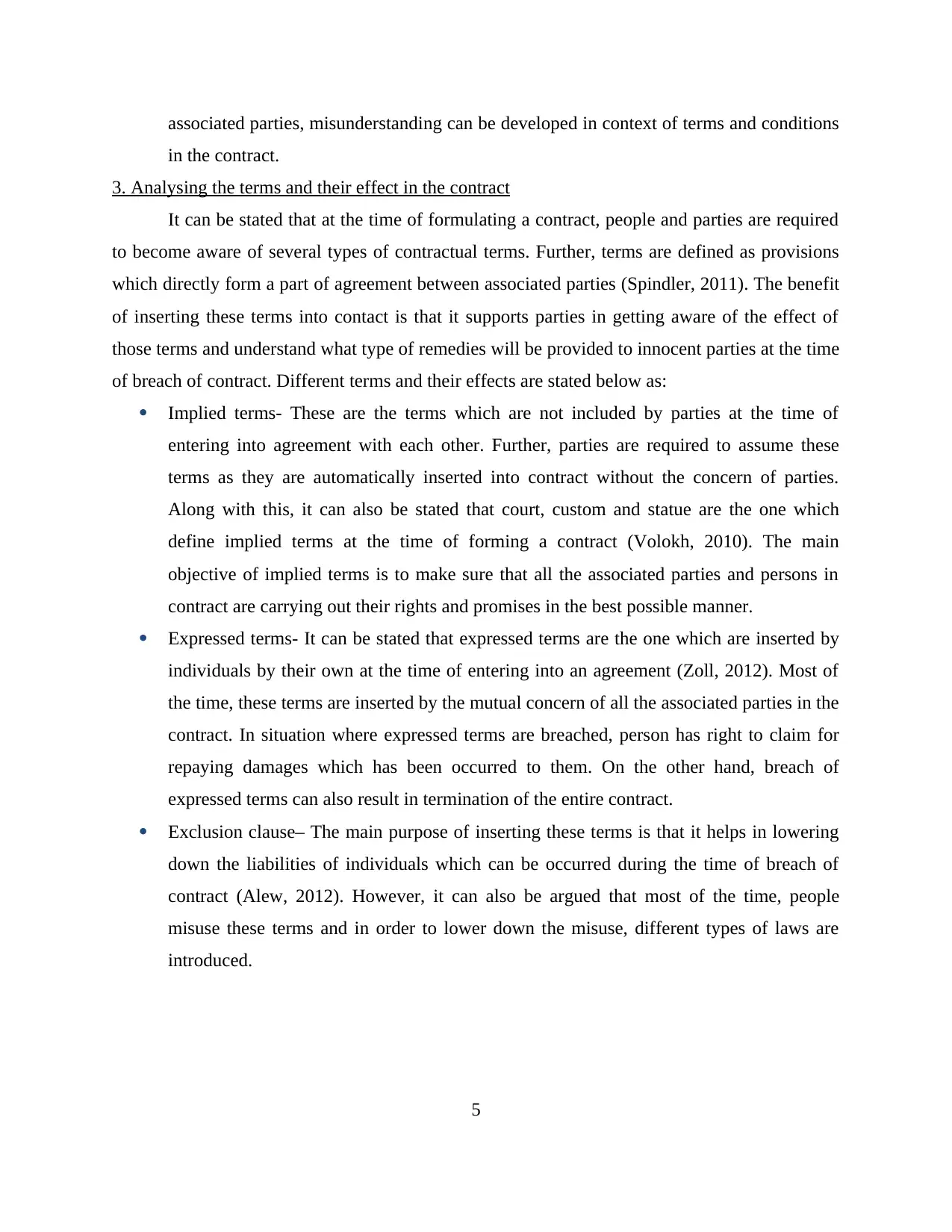
associated parties, misunderstanding can be developed in context of terms and conditions
in the contract.
3. Analysing the terms and their effect in the contract
It can be stated that at the time of formulating a contract, people and parties are required
to become aware of several types of contractual terms. Further, terms are defined as provisions
which directly form a part of agreement between associated parties (Spindler, 2011). The benefit
of inserting these terms into contact is that it supports parties in getting aware of the effect of
those terms and understand what type of remedies will be provided to innocent parties at the time
of breach of contract. Different terms and their effects are stated below as:
Implied terms- These are the terms which are not included by parties at the time of
entering into agreement with each other. Further, parties are required to assume these
terms as they are automatically inserted into contract without the concern of parties.
Along with this, it can also be stated that court, custom and statue are the one which
define implied terms at the time of forming a contract (Volokh, 2010). The main
objective of implied terms is to make sure that all the associated parties and persons in
contract are carrying out their rights and promises in the best possible manner.
Expressed terms- It can be stated that expressed terms are the one which are inserted by
individuals by their own at the time of entering into an agreement (Zoll, 2012). Most of
the time, these terms are inserted by the mutual concern of all the associated parties in the
contract. In situation where expressed terms are breached, person has right to claim for
repaying damages which has been occurred to them. On the other hand, breach of
expressed terms can also result in termination of the entire contract.
Exclusion clause– The main purpose of inserting these terms is that it helps in lowering
down the liabilities of individuals which can be occurred during the time of breach of
contract (Alew, 2012). However, it can also be argued that most of the time, people
misuse these terms and in order to lower down the misuse, different types of laws are
introduced.
5
in the contract.
3. Analysing the terms and their effect in the contract
It can be stated that at the time of formulating a contract, people and parties are required
to become aware of several types of contractual terms. Further, terms are defined as provisions
which directly form a part of agreement between associated parties (Spindler, 2011). The benefit
of inserting these terms into contact is that it supports parties in getting aware of the effect of
those terms and understand what type of remedies will be provided to innocent parties at the time
of breach of contract. Different terms and their effects are stated below as:
Implied terms- These are the terms which are not included by parties at the time of
entering into agreement with each other. Further, parties are required to assume these
terms as they are automatically inserted into contract without the concern of parties.
Along with this, it can also be stated that court, custom and statue are the one which
define implied terms at the time of forming a contract (Volokh, 2010). The main
objective of implied terms is to make sure that all the associated parties and persons in
contract are carrying out their rights and promises in the best possible manner.
Expressed terms- It can be stated that expressed terms are the one which are inserted by
individuals by their own at the time of entering into an agreement (Zoll, 2012). Most of
the time, these terms are inserted by the mutual concern of all the associated parties in the
contract. In situation where expressed terms are breached, person has right to claim for
repaying damages which has been occurred to them. On the other hand, breach of
expressed terms can also result in termination of the entire contract.
Exclusion clause– The main purpose of inserting these terms is that it helps in lowering
down the liabilities of individuals which can be occurred during the time of breach of
contract (Alew, 2012). However, it can also be argued that most of the time, people
misuse these terms and in order to lower down the misuse, different types of laws are
introduced.
5
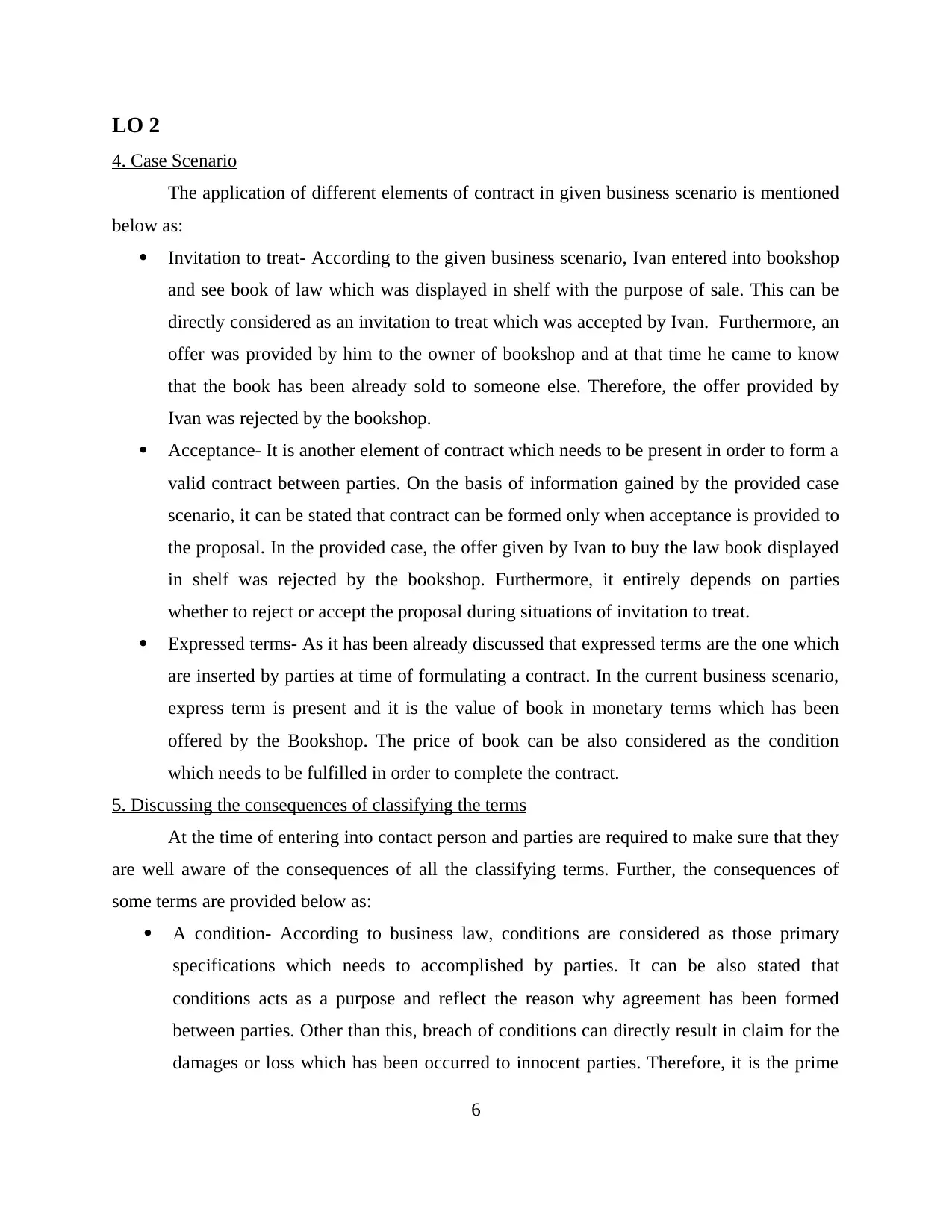
LO 2
4. Case Scenario
The application of different elements of contract in given business scenario is mentioned
below as:
Invitation to treat- According to the given business scenario, Ivan entered into bookshop
and see book of law which was displayed in shelf with the purpose of sale. This can be
directly considered as an invitation to treat which was accepted by Ivan. Furthermore, an
offer was provided by him to the owner of bookshop and at that time he came to know
that the book has been already sold to someone else. Therefore, the offer provided by
Ivan was rejected by the bookshop.
Acceptance- It is another element of contract which needs to be present in order to form a
valid contract between parties. On the basis of information gained by the provided case
scenario, it can be stated that contract can be formed only when acceptance is provided to
the proposal. In the provided case, the offer given by Ivan to buy the law book displayed
in shelf was rejected by the bookshop. Furthermore, it entirely depends on parties
whether to reject or accept the proposal during situations of invitation to treat.
Expressed terms- As it has been already discussed that expressed terms are the one which
are inserted by parties at time of formulating a contract. In the current business scenario,
express term is present and it is the value of book in monetary terms which has been
offered by the Bookshop. The price of book can be also considered as the condition
which needs to be fulfilled in order to complete the contract.
5. Discussing the consequences of classifying the terms
At the time of entering into contact person and parties are required to make sure that they
are well aware of the consequences of all the classifying terms. Further, the consequences of
some terms are provided below as:
A condition- According to business law, conditions are considered as those primary
specifications which needs to accomplished by parties. It can be also stated that
conditions acts as a purpose and reflect the reason why agreement has been formed
between parties. Other than this, breach of conditions can directly result in claim for the
damages or loss which has been occurred to innocent parties. Therefore, it is the prime
6
4. Case Scenario
The application of different elements of contract in given business scenario is mentioned
below as:
Invitation to treat- According to the given business scenario, Ivan entered into bookshop
and see book of law which was displayed in shelf with the purpose of sale. This can be
directly considered as an invitation to treat which was accepted by Ivan. Furthermore, an
offer was provided by him to the owner of bookshop and at that time he came to know
that the book has been already sold to someone else. Therefore, the offer provided by
Ivan was rejected by the bookshop.
Acceptance- It is another element of contract which needs to be present in order to form a
valid contract between parties. On the basis of information gained by the provided case
scenario, it can be stated that contract can be formed only when acceptance is provided to
the proposal. In the provided case, the offer given by Ivan to buy the law book displayed
in shelf was rejected by the bookshop. Furthermore, it entirely depends on parties
whether to reject or accept the proposal during situations of invitation to treat.
Expressed terms- As it has been already discussed that expressed terms are the one which
are inserted by parties at time of formulating a contract. In the current business scenario,
express term is present and it is the value of book in monetary terms which has been
offered by the Bookshop. The price of book can be also considered as the condition
which needs to be fulfilled in order to complete the contract.
5. Discussing the consequences of classifying the terms
At the time of entering into contact person and parties are required to make sure that they
are well aware of the consequences of all the classifying terms. Further, the consequences of
some terms are provided below as:
A condition- According to business law, conditions are considered as those primary
specifications which needs to accomplished by parties. It can be also stated that
conditions acts as a purpose and reflect the reason why agreement has been formed
between parties. Other than this, breach of conditions can directly result in claim for the
damages or loss which has been occurred to innocent parties. Therefore, it is the prime
6
⊘ This is a preview!⊘
Do you want full access?
Subscribe today to unlock all pages.

Trusted by 1+ million students worldwide
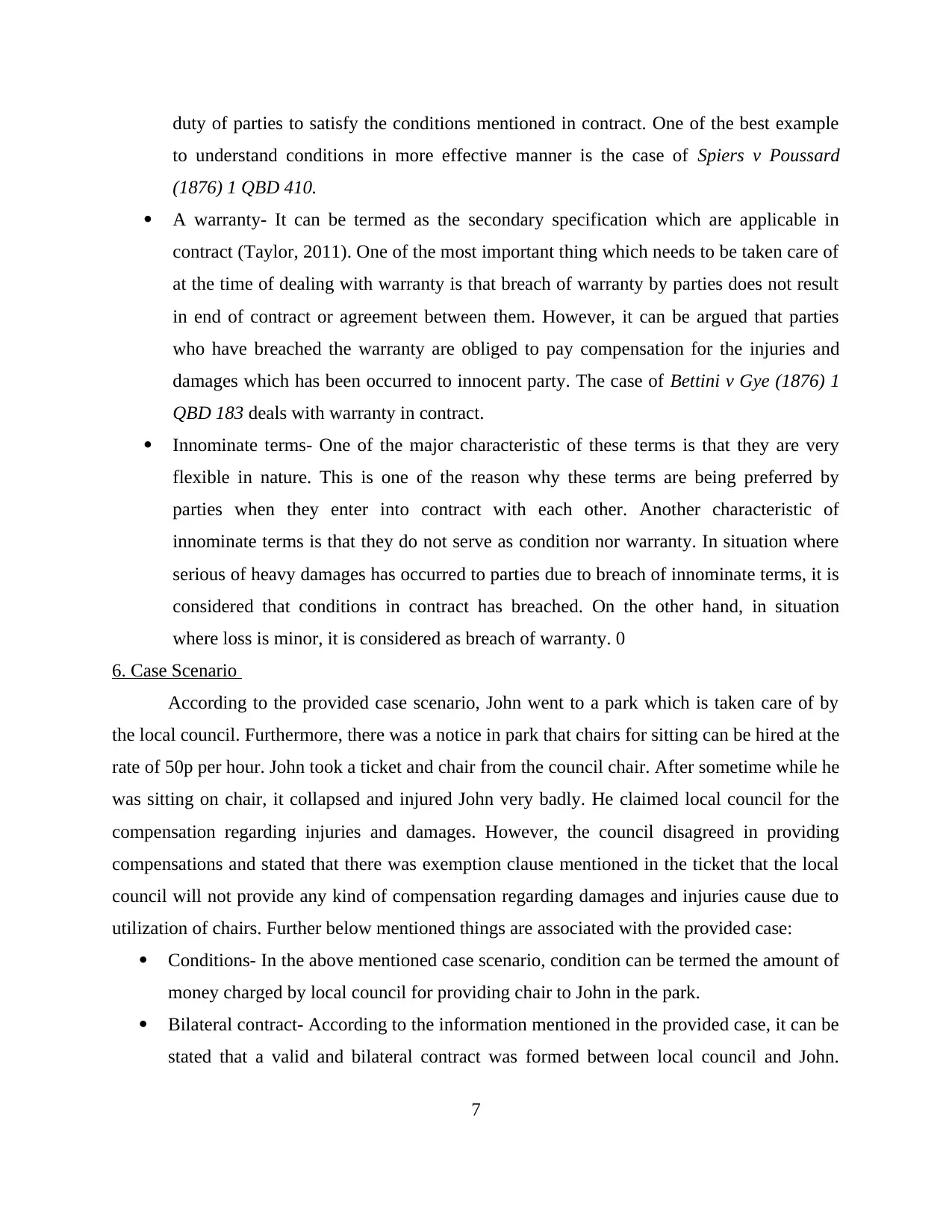
duty of parties to satisfy the conditions mentioned in contract. One of the best example
to understand conditions in more effective manner is the case of Spiers v Poussard
(1876) 1 QBD 410.
A warranty- It can be termed as the secondary specification which are applicable in
contract (Taylor, 2011). One of the most important thing which needs to be taken care of
at the time of dealing with warranty is that breach of warranty by parties does not result
in end of contract or agreement between them. However, it can be argued that parties
who have breached the warranty are obliged to pay compensation for the injuries and
damages which has been occurred to innocent party. The case of Bettini v Gye (1876) 1
QBD 183 deals with warranty in contract.
Innominate terms- One of the major characteristic of these terms is that they are very
flexible in nature. This is one of the reason why these terms are being preferred by
parties when they enter into contract with each other. Another characteristic of
innominate terms is that they do not serve as condition nor warranty. In situation where
serious of heavy damages has occurred to parties due to breach of innominate terms, it is
considered that conditions in contract has breached. On the other hand, in situation
where loss is minor, it is considered as breach of warranty. 0
6. Case Scenario
According to the provided case scenario, John went to a park which is taken care of by
the local council. Furthermore, there was a notice in park that chairs for sitting can be hired at the
rate of 50p per hour. John took a ticket and chair from the council chair. After sometime while he
was sitting on chair, it collapsed and injured John very badly. He claimed local council for the
compensation regarding injuries and damages. However, the council disagreed in providing
compensations and stated that there was exemption clause mentioned in the ticket that the local
council will not provide any kind of compensation regarding damages and injuries cause due to
utilization of chairs. Further below mentioned things are associated with the provided case:
Conditions- In the above mentioned case scenario, condition can be termed the amount of
money charged by local council for providing chair to John in the park.
Bilateral contract- According to the information mentioned in the provided case, it can be
stated that a valid and bilateral contract was formed between local council and John.
7
to understand conditions in more effective manner is the case of Spiers v Poussard
(1876) 1 QBD 410.
A warranty- It can be termed as the secondary specification which are applicable in
contract (Taylor, 2011). One of the most important thing which needs to be taken care of
at the time of dealing with warranty is that breach of warranty by parties does not result
in end of contract or agreement between them. However, it can be argued that parties
who have breached the warranty are obliged to pay compensation for the injuries and
damages which has been occurred to innocent party. The case of Bettini v Gye (1876) 1
QBD 183 deals with warranty in contract.
Innominate terms- One of the major characteristic of these terms is that they are very
flexible in nature. This is one of the reason why these terms are being preferred by
parties when they enter into contract with each other. Another characteristic of
innominate terms is that they do not serve as condition nor warranty. In situation where
serious of heavy damages has occurred to parties due to breach of innominate terms, it is
considered that conditions in contract has breached. On the other hand, in situation
where loss is minor, it is considered as breach of warranty. 0
6. Case Scenario
According to the provided case scenario, John went to a park which is taken care of by
the local council. Furthermore, there was a notice in park that chairs for sitting can be hired at the
rate of 50p per hour. John took a ticket and chair from the council chair. After sometime while he
was sitting on chair, it collapsed and injured John very badly. He claimed local council for the
compensation regarding injuries and damages. However, the council disagreed in providing
compensations and stated that there was exemption clause mentioned in the ticket that the local
council will not provide any kind of compensation regarding damages and injuries cause due to
utilization of chairs. Further below mentioned things are associated with the provided case:
Conditions- In the above mentioned case scenario, condition can be termed the amount of
money charged by local council for providing chair to John in the park.
Bilateral contract- According to the information mentioned in the provided case, it can be
stated that a valid and bilateral contract was formed between local council and John.
7
Paraphrase This Document
Need a fresh take? Get an instant paraphrase of this document with our AI Paraphraser
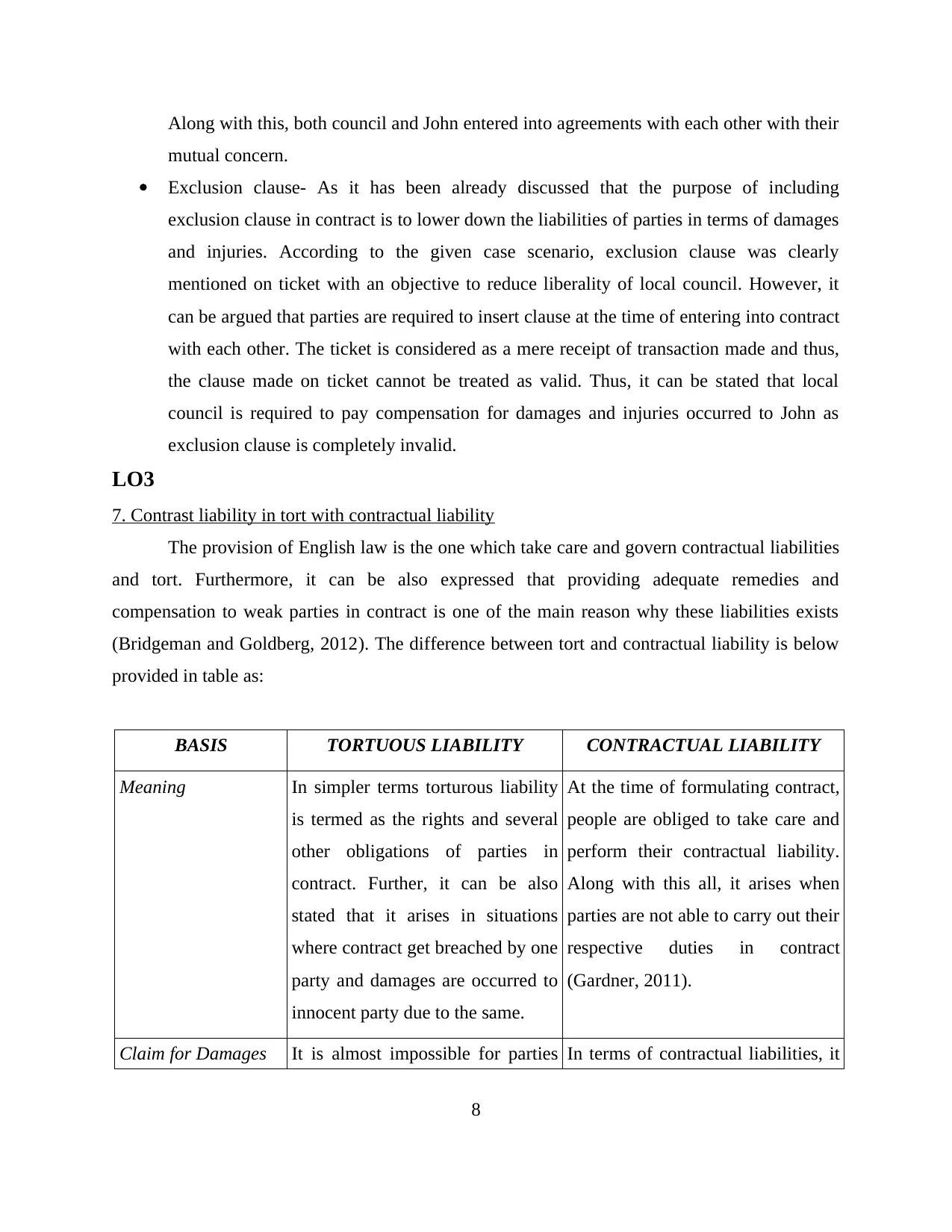
Along with this, both council and John entered into agreements with each other with their
mutual concern.
Exclusion clause- As it has been already discussed that the purpose of including
exclusion clause in contract is to lower down the liabilities of parties in terms of damages
and injuries. According to the given case scenario, exclusion clause was clearly
mentioned on ticket with an objective to reduce liberality of local council. However, it
can be argued that parties are required to insert clause at the time of entering into contract
with each other. The ticket is considered as a mere receipt of transaction made and thus,
the clause made on ticket cannot be treated as valid. Thus, it can be stated that local
council is required to pay compensation for damages and injuries occurred to John as
exclusion clause is completely invalid.
LO3
7. Contrast liability in tort with contractual liability
The provision of English law is the one which take care and govern contractual liabilities
and tort. Furthermore, it can be also expressed that providing adequate remedies and
compensation to weak parties in contract is one of the main reason why these liabilities exists
(Bridgeman and Goldberg, 2012). The difference between tort and contractual liability is below
provided in table as:
BASIS TORTUOUS LIABILITY CONTRACTUAL LIABILITY
Meaning In simpler terms torturous liability
is termed as the rights and several
other obligations of parties in
contract. Further, it can be also
stated that it arises in situations
where contract get breached by one
party and damages are occurred to
innocent party due to the same.
At the time of formulating contract,
people are obliged to take care and
perform their contractual liability.
Along with this all, it arises when
parties are not able to carry out their
respective duties in contract
(Gardner, 2011).
Claim for Damages It is almost impossible for parties In terms of contractual liabilities, it
8
mutual concern.
Exclusion clause- As it has been already discussed that the purpose of including
exclusion clause in contract is to lower down the liabilities of parties in terms of damages
and injuries. According to the given case scenario, exclusion clause was clearly
mentioned on ticket with an objective to reduce liberality of local council. However, it
can be argued that parties are required to insert clause at the time of entering into contract
with each other. The ticket is considered as a mere receipt of transaction made and thus,
the clause made on ticket cannot be treated as valid. Thus, it can be stated that local
council is required to pay compensation for damages and injuries occurred to John as
exclusion clause is completely invalid.
LO3
7. Contrast liability in tort with contractual liability
The provision of English law is the one which take care and govern contractual liabilities
and tort. Furthermore, it can be also expressed that providing adequate remedies and
compensation to weak parties in contract is one of the main reason why these liabilities exists
(Bridgeman and Goldberg, 2012). The difference between tort and contractual liability is below
provided in table as:
BASIS TORTUOUS LIABILITY CONTRACTUAL LIABILITY
Meaning In simpler terms torturous liability
is termed as the rights and several
other obligations of parties in
contract. Further, it can be also
stated that it arises in situations
where contract get breached by one
party and damages are occurred to
innocent party due to the same.
At the time of formulating contract,
people are obliged to take care and
perform their contractual liability.
Along with this all, it arises when
parties are not able to carry out their
respective duties in contract
(Gardner, 2011).
Claim for Damages It is almost impossible for parties In terms of contractual liabilities, it
8

to determining their performance
criteria as no specific rules are
developed to evaluate the same.
This means that the claim for
damages are determined on the
basis of situations which are
prevailing in the contract (Fried,
2015). It can be also stated that in
situations when one party is found
as defaulter then it is required to
pay compensation for the loss
occurred to another party in
contract.
can be stated that it is the
contractual agreement between
person or parties which is taken into
consideration at the time of
determining claim for damages.
When in situations where it has
been found that terms and
conditions mentioned in contract are
breached then parties are required to
pay for damages.
Relationship of
Parties
In terms of tort liability it can be
stated that there is no relationship
exist among parties.
There is a direct and legal
relationship which exist among
parties in contractual liabilities.
Along with this, they are also
required to perform their roles and
duties which are mentioned in
contract.
Case Example The case of Nettelship v Weston
can be taken into consideration for
understanding tort liability
Tesco v Constable can be taken into
account in terms of contractual;
liability.
8. Explaining the nature of liability in Negligence
In simpler terms, negligence can be termed as the situation which has caused harm and
damages to one party because one party failed to make utilization of their reasonable care. There
9
criteria as no specific rules are
developed to evaluate the same.
This means that the claim for
damages are determined on the
basis of situations which are
prevailing in the contract (Fried,
2015). It can be also stated that in
situations when one party is found
as defaulter then it is required to
pay compensation for the loss
occurred to another party in
contract.
can be stated that it is the
contractual agreement between
person or parties which is taken into
consideration at the time of
determining claim for damages.
When in situations where it has
been found that terms and
conditions mentioned in contract are
breached then parties are required to
pay for damages.
Relationship of
Parties
In terms of tort liability it can be
stated that there is no relationship
exist among parties.
There is a direct and legal
relationship which exist among
parties in contractual liabilities.
Along with this, they are also
required to perform their roles and
duties which are mentioned in
contract.
Case Example The case of Nettelship v Weston
can be taken into consideration for
understanding tort liability
Tesco v Constable can be taken into
account in terms of contractual;
liability.
8. Explaining the nature of liability in Negligence
In simpler terms, negligence can be termed as the situation which has caused harm and
damages to one party because one party failed to make utilization of their reasonable care. There
9
⊘ This is a preview!⊘
Do you want full access?
Subscribe today to unlock all pages.

Trusted by 1+ million students worldwide

are some situations in which parties become entirely incapable of accomplishing their respective
duties and this results in damages to other parties in contract. Thus, it is the right of every party
to claim for damages which are caused to them. Furthermore, the case of Donoghue v Stevenson
[1932] AC 562 is considered as one the best example for understanding liabilities in negligence.
Elements of negligence
It can be stated that there are four most important elements which needs be taken care of
and which play very important role in providing compensations to parties in cases where
negligence. Elements are mentioned below as:
Duty of care- In case of Donoghue v Stevenson [1932] AC 562, the court clearly
mentioned that at the time of entering into agreement parties are required to make sure
that their duty to care is accomplished in the best possible manner.
Breach of duty- It can be termed as the situation in which people in contract are not able
to fulfil their respective duties which are defined by laws.
Causation- Negligence from one party can be defined as one of the most important cause
which can result in creating various damages to a person. In case of Donoghue v
Stevenson [1932] AC 562, it was the negligence of manufactures which caused damages
to consumer.
Remoteness- It is another essential element which is required in order to prove
negligence. Remoteness means that the injuries and damages which has been happened to
party must be foreseeable.
9. Explaining how a business can be vicariously liable
According to the law defined in England, vicarious liability can be termed as the situation
in which employer are held responsible for them wrong act carried out their employees.
Furthermore, in order to understand the case of vicarious liability in more effective manner the
case of child and mother can be taken into consideration (Rose, 2009). According to the case,
every mother is responsible for the wrongful act carried out by her child. In the same way
organizations are held completely responsible for their employees Furthermore, vicariously
liability is applicable in the following case only:
Any harm or wrong conducted by employee musty be during the working hours
10
duties and this results in damages to other parties in contract. Thus, it is the right of every party
to claim for damages which are caused to them. Furthermore, the case of Donoghue v Stevenson
[1932] AC 562 is considered as one the best example for understanding liabilities in negligence.
Elements of negligence
It can be stated that there are four most important elements which needs be taken care of
and which play very important role in providing compensations to parties in cases where
negligence. Elements are mentioned below as:
Duty of care- In case of Donoghue v Stevenson [1932] AC 562, the court clearly
mentioned that at the time of entering into agreement parties are required to make sure
that their duty to care is accomplished in the best possible manner.
Breach of duty- It can be termed as the situation in which people in contract are not able
to fulfil their respective duties which are defined by laws.
Causation- Negligence from one party can be defined as one of the most important cause
which can result in creating various damages to a person. In case of Donoghue v
Stevenson [1932] AC 562, it was the negligence of manufactures which caused damages
to consumer.
Remoteness- It is another essential element which is required in order to prove
negligence. Remoteness means that the injuries and damages which has been happened to
party must be foreseeable.
9. Explaining how a business can be vicariously liable
According to the law defined in England, vicarious liability can be termed as the situation
in which employer are held responsible for them wrong act carried out their employees.
Furthermore, in order to understand the case of vicarious liability in more effective manner the
case of child and mother can be taken into consideration (Rose, 2009). According to the case,
every mother is responsible for the wrongful act carried out by her child. In the same way
organizations are held completely responsible for their employees Furthermore, vicariously
liability is applicable in the following case only:
Any harm or wrong conducted by employee musty be during the working hours
10
Paraphrase This Document
Need a fresh take? Get an instant paraphrase of this document with our AI Paraphraser
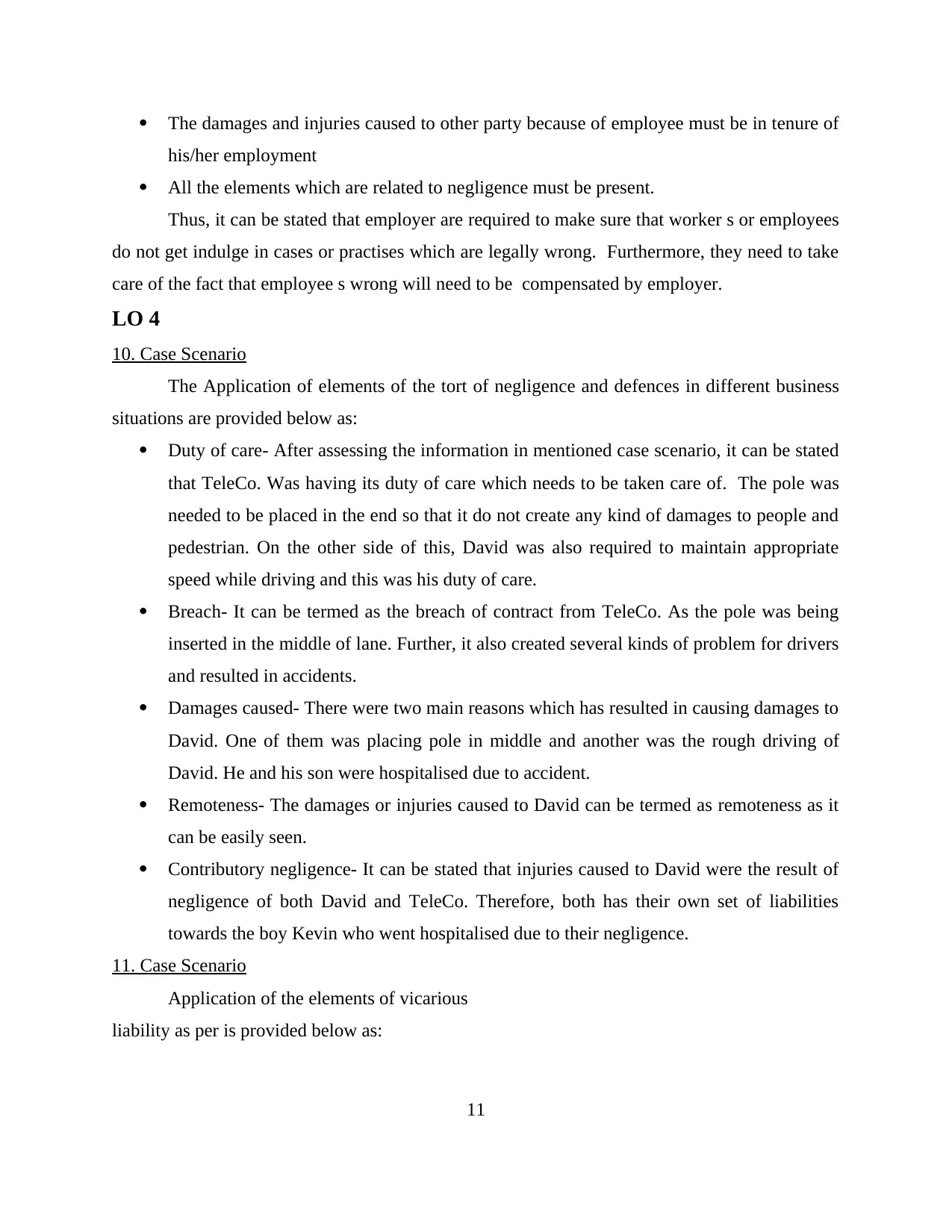
The damages and injuries caused to other party because of employee must be in tenure of
his/her employment
All the elements which are related to negligence must be present.
Thus, it can be stated that employer are required to make sure that worker s or employees
do not get indulge in cases or practises which are legally wrong. Furthermore, they need to take
care of the fact that employee s wrong will need to be compensated by employer.
LO 4
10. Case Scenario
The Application of elements of the tort of negligence and defences in different business
situations are provided below as:
Duty of care- After assessing the information in mentioned case scenario, it can be stated
that TeleCo. Was having its duty of care which needs to be taken care of. The pole was
needed to be placed in the end so that it do not create any kind of damages to people and
pedestrian. On the other side of this, David was also required to maintain appropriate
speed while driving and this was his duty of care.
Breach- It can be termed as the breach of contract from TeleCo. As the pole was being
inserted in the middle of lane. Further, it also created several kinds of problem for drivers
and resulted in accidents.
Damages caused- There were two main reasons which has resulted in causing damages to
David. One of them was placing pole in middle and another was the rough driving of
David. He and his son were hospitalised due to accident.
Remoteness- The damages or injuries caused to David can be termed as remoteness as it
can be easily seen.
Contributory negligence- It can be stated that injuries caused to David were the result of
negligence of both David and TeleCo. Therefore, both has their own set of liabilities
towards the boy Kevin who went hospitalised due to their negligence.
11. Case Scenario
Application of the elements of vicarious
liability as per is provided below as:
11
his/her employment
All the elements which are related to negligence must be present.
Thus, it can be stated that employer are required to make sure that worker s or employees
do not get indulge in cases or practises which are legally wrong. Furthermore, they need to take
care of the fact that employee s wrong will need to be compensated by employer.
LO 4
10. Case Scenario
The Application of elements of the tort of negligence and defences in different business
situations are provided below as:
Duty of care- After assessing the information in mentioned case scenario, it can be stated
that TeleCo. Was having its duty of care which needs to be taken care of. The pole was
needed to be placed in the end so that it do not create any kind of damages to people and
pedestrian. On the other side of this, David was also required to maintain appropriate
speed while driving and this was his duty of care.
Breach- It can be termed as the breach of contract from TeleCo. As the pole was being
inserted in the middle of lane. Further, it also created several kinds of problem for drivers
and resulted in accidents.
Damages caused- There were two main reasons which has resulted in causing damages to
David. One of them was placing pole in middle and another was the rough driving of
David. He and his son were hospitalised due to accident.
Remoteness- The damages or injuries caused to David can be termed as remoteness as it
can be easily seen.
Contributory negligence- It can be stated that injuries caused to David were the result of
negligence of both David and TeleCo. Therefore, both has their own set of liabilities
towards the boy Kevin who went hospitalised due to their negligence.
11. Case Scenario
Application of the elements of vicarious
liability as per is provided below as:
11

Vicarious liability- According to the provided case, the employee has completely done wrongful
act by hitting the frying pan on Roger. Therefore, the act is carried out under employment which
means that it is the duty of employer to pay for the compensation against damages and injuries to
roger. Along with this, he also has complete rights to claim the hotel for compensation.
Principles related to vicarious liabilities- All the principles related to vicariously liability has
been satisfied in the provided case scenario of Regent Hotel. One of the major principle was that
the wrongful act needs to be conducted during working hours which was accomplished. Along
with this, Collin was also working for Regent Hotel at the time when he conducted the act.
CONCLUSION
From the above carried out study, it can be stated that offer, acceptance, intention to
create legal relationship and consideration are the major elements required to form a valid
contract. Along with this, it can be also inferred that verbal, written and distance selling contract
are the three different type of contract. From the above report, it can be also concluded that
breach of condition results in breach of contract whereas breach of warranty may results in
compensation for damages but not in breach of entire agreements. On the other side of this, it can
be inferred that according to vicarious liability during employment if a worker has carried out
any wrong act, then employer will be held responsible for the same and require to pay
compensation for the same.
12
act by hitting the frying pan on Roger. Therefore, the act is carried out under employment which
means that it is the duty of employer to pay for the compensation against damages and injuries to
roger. Along with this, he also has complete rights to claim the hotel for compensation.
Principles related to vicarious liabilities- All the principles related to vicariously liability has
been satisfied in the provided case scenario of Regent Hotel. One of the major principle was that
the wrongful act needs to be conducted during working hours which was accomplished. Along
with this, Collin was also working for Regent Hotel at the time when he conducted the act.
CONCLUSION
From the above carried out study, it can be stated that offer, acceptance, intention to
create legal relationship and consideration are the major elements required to form a valid
contract. Along with this, it can be also inferred that verbal, written and distance selling contract
are the three different type of contract. From the above report, it can be also concluded that
breach of condition results in breach of contract whereas breach of warranty may results in
compensation for damages but not in breach of entire agreements. On the other side of this, it can
be inferred that according to vicarious liability during employment if a worker has carried out
any wrong act, then employer will be held responsible for the same and require to pay
compensation for the same.
12
⊘ This is a preview!⊘
Do you want full access?
Subscribe today to unlock all pages.

Trusted by 1+ million students worldwide
1 out of 14
Related Documents
Your All-in-One AI-Powered Toolkit for Academic Success.
+13062052269
info@desklib.com
Available 24*7 on WhatsApp / Email
![[object Object]](/_next/static/media/star-bottom.7253800d.svg)
Unlock your academic potential
Copyright © 2020–2025 A2Z Services. All Rights Reserved. Developed and managed by ZUCOL.





